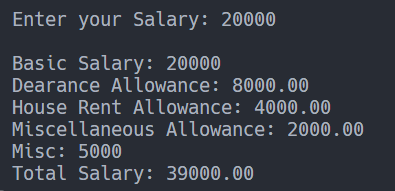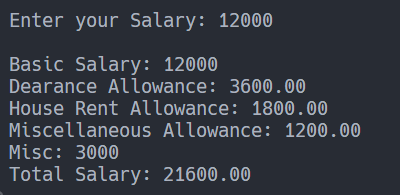Calculating an employee's salary requires careful consideration of various allowances, such as dearness allowance, house rent allowance, medical allowance, and miscellaneous expenses. These allowances significantly impact the overall earnings of an employee. In this coding blog, we will dive into a detailed explanation of a C program that incorporates these allowances to accurately calculate an employee's salary.
This blog post will walk you through a step-by-step guide on using C programming to create a salary calculation program that includes different allowances. We'll begin by introducing the necessary variables, such as salary, hRAllowance, Dearness Allowance, medicalAllowance, miscellaneous, and total salary.
Next, we'll explain how to obtain user input using the scanf function for variables like salary, and how to calculate the salary for the employee.
Code Explanation
The program begins by clearing the console screen to ensure a clean and organized display. It then declares the necessary variables for storing the salary, miscellaneous allowance, dearness allowance, house rent allowance, medical allowance, and the total salary. Tand ser is prompted to enter their salary, which is then stored in the 'salary' variable.
Based on the entered salary, the program uses conditional statements to calculate the respective allowances. If the salary is above 15000, it calculates the dearness allowance as 40% of the salary, house rent allowance as 20% of the salary, and medical allowance as 10% of the salary. It assigns a fixed miscellaneous allowance of 5000. On the other hand, if the salary is less than or equal to 15000, the program calculates the dearness allowance as 30% of the salary, house rent allowance as 15% of the salary, and medical allowance as 10% of the salary. It assigns a fixed miscellaneous allowance of 3000.
To enhance the understanding of readers, the blog post will provide the complete C program code with clear comments explaining each section. This will enable readers to easily comprehend and modify the code according to their specific requirements, such as adjusting the allowance rates or adding new allowances.
The blog post will also discuss the significance of considering factors like tax deductions, additional bonuses, and other deductions that may affect the net take-home salary. While this basic program does not cover these aspects, readers will be encouraged to expand and customize the code to suit their needs.
Conclusion
By the end of this blog post, readers will have gained a solid understanding of how to utilize C programming to calculate an employee's salary while incorporating various allowances. They will possess a functional program that accounts for factors such as home rent allowance, travel allowance, medical allowance, and miscellaneous expenses.
This blog post serves as a valuable resource for individuals who are new to programming or seeking to expand their knowledge. It empowers readers to develop their own salary calculation programs using C, enabling them to tailor the code to fit their organization's specific allowances and requirements.
Ultimately, this program offers a foundation upon which readers can build more advanced salary calculation systems, taking into account additional complexities like taxes, deductions, and bonuses to create a comprehensive and accurate salary calculation tool.






0 Comments